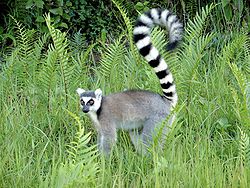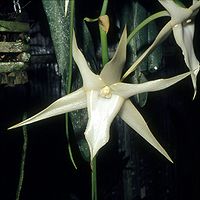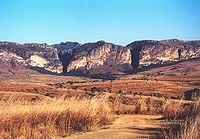
Wildlife of Madagascar
Encyclopedia

Madagascar
The Republic of Madagascar is an island country located in the Indian Ocean off the southeastern coast of Africa...
is composed of its flora
Flora
Flora is the plant life occurring in a particular region or time, generally the naturally occurring or indigenous—native plant life. The corresponding term for animals is fauna.-Etymology:...
and fauna
Fauna
Fauna or faunæ is all of the animal life of any particular region or time. The corresponding term for plants is flora.Zoologists and paleontologists use fauna to refer to a typical collection of animals found in a specific time or place, e.g. the "Sonoran Desert fauna" or the "Burgess shale fauna"...
. The island has been isolated for about 70 million years. Because of this, a very high proportion of the plants and animals are endemic, occurring nowhere else in the world. Many species are related to those found in mainland Africa
Africa
Africa is the world's second largest and second most populous continent, after Asia. At about 30.2 million km² including adjacent islands, it covers 6% of the Earth's total surface area and 20.4% of the total land area...
but others have Asia
Asia
Asia is the world's largest and most populous continent, located primarily in the eastern and northern hemispheres. It covers 8.7% of the Earth's total surface area and with approximately 3.879 billion people, it hosts 60% of the world's current human population...
n affinities. A few are related to species found in South America
South America
South America is a continent situated in the Western Hemisphere, mostly in the Southern Hemisphere, with a relatively small portion in the Northern Hemisphere. The continent is also considered a subcontinent of the Americas. It is bordered on the west by the Pacific Ocean and on the north and east...
and the South Pacific
Oceania
Oceania is a region centered on the islands of the tropical Pacific Ocean. Conceptions of what constitutes Oceania range from the coral atolls and volcanic islands of the South Pacific to the entire insular region between Asia and the Americas, including Australasia and the Malay Archipelago...
, relics of the time when these landmasses formed part of Gondwanaland.
Flora

Vascular plant
Vascular plants are those plants that have lignified tissues for conducting water, minerals, and photosynthetic products through the plant. Vascular plants include the clubmosses, Equisetum, ferns, gymnosperms and angiosperms...
of which about 80% are endemic. There are several endemic families including the Asteropeiaceae
Asteropeiaceae
Asteropeiaceae is the botanical name for a family of flowering plants. Such a family has been recognized by very few taxonomists.The APG II system, of 2003 does recognize such a family and assigns it to the order Caryophyllales in the clade core eudicots...
, Sarcolaenaceae
Sarcolaenaceae
The Sarcolaenaceae are a family of flowering plants endemic to Madagascar. The family includes 40 species of mostly evergreen trees and shrubs in ten genera....
and Sphaerosepalaceae
Sphaerosepalaceae
Sphaerosepalaceae is a family of flowering plants. It contains 14 species of trees and shrubs in two genera, Dialyceras and Rhopalocarpus, all of which are endemic to Madagascar. The family is alternatively known as the Rhopalocarpaceae....
.
The humid eastern part of the island was formerly covered in rainforest
Rainforest
Rainforests are forests characterized by high rainfall, with definitions based on a minimum normal annual rainfall of 1750-2000 mm...
with many palms
Arecaceae
Arecaceae or Palmae , are a family of flowering plants, the only family in the monocot order Arecales. There are roughly 202 currently known genera with around 2600 species, most of which are restricted to tropical, subtropical, and warm temperate climates...
, fern
Fern
A fern is any one of a group of about 12,000 species of plants belonging to the botanical group known as Pteridophyta. Unlike mosses, they have xylem and phloem . They have stems, leaves, and roots like other vascular plants...
s and bamboo
Bamboo
Bamboo is a group of perennial evergreens in the true grass family Poaceae, subfamily Bambusoideae, tribe Bambuseae. Giant bamboos are the largest members of the grass family....
; much of this has now been destroyed by human activity. The west has areas of dry deciduous forest
Madagascar dry deciduous forests
The Madagascar dry deciduous forests represent a tropical dry forest ecoregion generally situated in the western part of Madagascar. The area has high numbers of endemic plant and animal species but has suffered large-scale clearance for agriculture...
with many liana
Liana
A liana is any of various long-stemmed, woody vines that are rooted in the soil at ground level and use trees, as well as other means of vertical support, to climb up to the canopy to get access to well-lit areas of the forest. Lianas are especially characteristic of tropical moist deciduous...
s and with tamarind
Tamarind
Tamarind is a tree in the family Fabaceae. The genus Tamarindus is monotypic .-Origin:...
and baobab
Baobab
Adansonia is a genus of eight species of tree, six native to Madagascar, one native to mainland Africa and the Arabian Peninsula and one to Australia. The mainland African species also occurs on Madagascar, but it is not a native of that island....
s among the dominant trees. Spiny bushland
Madagascar spiny thickets
The Madagascar spiny thickets is an ecoregion in Madagascar. The vegetation type is found on poor substrates with low, erratic winter rainfall. An estimated 14,000 to is covered with this habitat, all in the southwest of the country...
occurs in the south-west with many cactus-like plants of the Didiereaceae
Didiereaceae
Didiereaceae is a small family of just four genera and 11 species of flowering plants endemic to south and southwest Madagascar, where they form an important component of the Madagascar spiny forests.-Description:...
family and many species of Euphorbia. Subhumid forest
Madagascar subhumid forests
The Madagascar subhumid forests are a tropical moist broadleaf forest ecoregion which originally covered most of the Central Highlands of the island of Madagascar.-Setting:...
once covered much of the central plateau but grassland
Grassland
Grasslands are areas where the vegetation is dominated by grasses and other herbaceous plants . However, sedge and rush families can also be found. Grasslands occur naturally on all continents except Antarctica...
is now the dominant vegetation type there.
Conservation

Habitat destruction
Habitat destruction is the process in which natural habitat is rendered functionally unable to support the species present. In this process, the organisms that previously used the site are displaced or destroyed, reducing biodiversity. Habitat destruction by human activity mainly for the purpose of...
. Large areas of forest have been felled and wetlands have been drained. Introduced species
Introduced species
An introduced species — or neozoon, alien, exotic, non-indigenous, or non-native species, or simply an introduction, is a species living outside its indigenous or native distributional range, and has arrived in an ecosystem or plant community by human activity, either deliberate or accidental...
have spread into native habitats. A number of endemic species are threatened by hunting
Hunting
Hunting is the practice of pursuing any living thing, usually wildlife, for food, recreation, or trade. In present-day use, the term refers to lawful hunting, as distinguished from poaching, which is the killing, trapping or capture of the hunted species contrary to applicable law...
.
Some species have already become extinct, particularly large species such as the elephant bird
Elephant bird
Elephant birds are an extinct family of flightless birds found only on the island of Madagascar and comprising the genera Aepyornis and Mullerornis.-Description:...
s, Malagasy hippopotamus
Malagasy Hippopotamus
Several species of Malagasy Hippopotamus lived on the island of Madagascar but are now believed to be extinct. The animals were very similar to the extant Hippopotamus and Pygmy Hippopotamus...
es and giant lemurs like Megaladapis
Megaladapis
Koala lemurs, genus Megaladapis, belong to the family Megaladapidae, consisting of three extinct species of lemurs that once inhabited the island of Madagascar. The largest measured between in length.-Appearance and habits:...
. Many surviving species are endangered
Endangered species
An endangered species is a population of organisms which is at risk of becoming extinct because it is either few in numbers, or threatened by changing environmental or predation parameters...
including most of the lemurs.
A network of national park
National park
A national park is a reserve of natural, semi-natural, or developed land that a sovereign state declares or owns. Although individual nations designate their own national parks differently A national park is a reserve of natural, semi-natural, or developed land that a sovereign state declares or...
s and nature reserve
Nature reserve
A nature reserve is a protected area of importance for wildlife, flora, fauna or features of geological or other special interest, which is reserved and managed for conservation and to provide special opportunities for study or research...
s has been set up to protect wildlife and their habitats. A number of organizations are involved in conservation on the island including the World Wide Fund for Nature
World Wide Fund for Nature
The World Wide Fund for Nature is an international non-governmental organization working on issues regarding the conservation, research and restoration of the environment, formerly named the World Wildlife Fund, which remains its official name in Canada and the United States...
, Madagascar Fauna Group
Madagascar Fauna Group
The Madagascar Fauna Group or MFG is an international consortium of zoos and other conservation agencies which pool together resources to help conserve animal species in Madagascar, through captive breeding programs, field research programs, training programs for rangers and wardens, and...
and BirdLife International
BirdLife International
BirdLife International is a global Partnership of conservation organisations that strives to conserve birds, their habitats and global biodiversity, working with people towards sustainability in the use of natural resources...
. Captive breeding
Captive breeding
Captive breedingis the process of breeding animals in human controlled environments with restricted settings, such as wildlife reserves, zoos and other conservation facilities; sometimes the process is construed to include release of individual organisms to the wild, when there is sufficient...
programs have been set up to conserve some of the lemurs.

